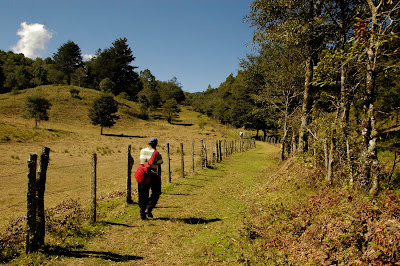Today was a day of travelling, finished off with watching the sunset over the jungle from atop a Mayan temple, the second highest
pre-
Columbian structure in the Americas, at the ancient city of
Tikal.
I left San Ignacio fairly early in order to make easy connections -- a rickety bus to a town near the border, a beat up shared taxi to the border, and by foot over the border. Then two hours squished into a
sweltering minibus with 29 other people including babies being breast fed and the driver. I got dropped off at a crossroads where I waited less than five minutes to flag down a tourist shuttle bus coming from Flores to
Tikal.
It all went very smoothly despite the uncertainty of timetables, and it was a lot cheaper than the taxis from the border whose drivers wanted to charge me $60, telling me there was no other way. The moral of the story is that although many taxi drivers are honest, a lot cannot be believed if they stand to make a buck. Like the one in San Ignacio who tried to claim the buses only ran hourly on Sundays, hoping I would give up and take a taxi, when in fact buses ran on the half hour as normal.
I wanted to stay overnight in
Tikal because sunset and sunrise are the most interesting times -- both for the skies and for the animals that come out at dawn and dusk. The cheapest hotel said they had an unpaid reservation that they could give me if I waited 15 minutes till noon. But after paying for the room, they said it wouldn't be ready until check-in time at 2 p.m. I didn't plan to go to the ruins until 4 p.m. anyway, so I waited around -- only to find out that the person who previously had the room they were going to give me hadn't checked out. In the end they found me a room in a more expensive hotel and refunded my money, but it was a hassle.
There are two prices of admission to
Tikal -- a cheap price ($3) for Guatemalans, and an expensive price ($24) for Gringos. But I knew that if you buy a ticket after 4 p.m., they stamp your ticket for the next day, and you can still get in for the remainder of the day until closing time at 6 p.m. So I went for a couple hours in the late afternoon, knowing I can return tomorrow.
Tikal is quite large. It was a major city in its day. There are a number of tall temples, and many of them have not yet been unearthed and are still
jungley mounds. What makes the place so special is the setting surrounded by jungle. Even in the day you see exotic birds like toucans,
Peten turkeys, and numerous others I can't identify. There are howler monkeys, and
coatamundis. As dusk approaches, the sounds reach a pitch of crickets, birds, and other noises.
I visited a couple of the temples in the main plaza. They've now added wooden steps to climb one because the original stone steps were too steep and have resulted in a few fatal accidents of tourists. The other one you can't climb at all.
After that, I hurried over to the tallest one, temple IV, which is known for its sunrises and sunsets. I was not disappointed. There were other tourists and photography enthusiasts there already, as the sun lowered in the sky. It cast orange light patterns across a couple of temples in the distance, and over top of the jungle foliage. Very dramatic.
It's 35 minutes back to the main gate, and I knew I had to move quickly so as not to get caught in the dark. As it was, there was only a trace of light -- just enough to see roots, stumps and steps on the trail as I approached the gate. The jungle sounds and animals though were amazing.
Tomorrow I'll be up early to see more.























































